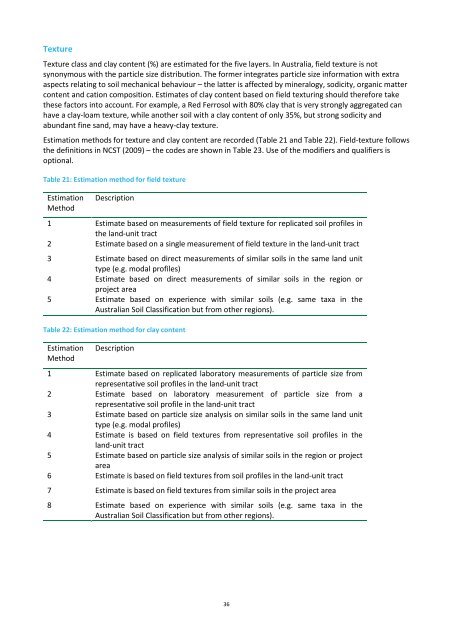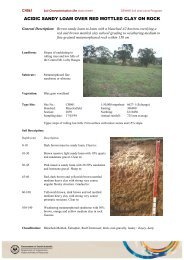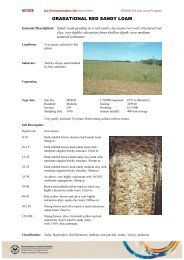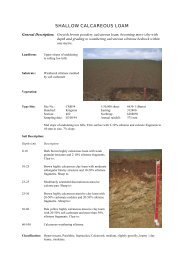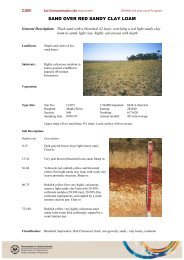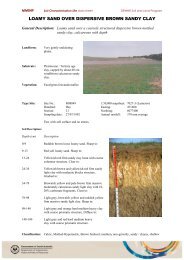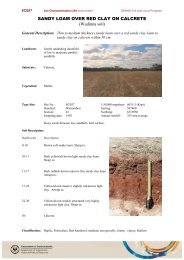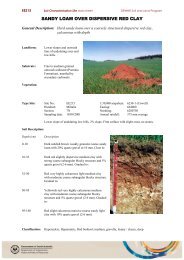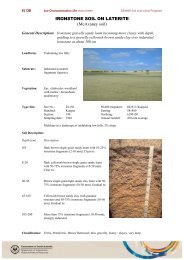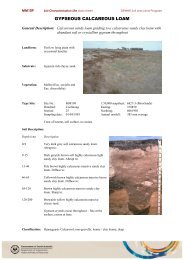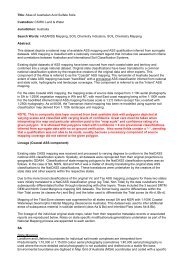TextureTexture class and clay content (%) are estimated for the five layers. In Australia, field texture is notsynonymous with the particle size distribution. The former integrates particle size information with extraaspects relating to soil mechanical behaviour – the latter is affected by mineralogy, sodicity, organic mattercontent and cation composition. Estimates of clay content based on field texturing should therefore takethese factors into account. For example, a Red Ferrosol with 80% clay that is very strongly aggregated canhave a clay-loam texture, while another soil with a clay content of only 35%, but strong sodicity andabundant fine sand, may have a heavy-clay texture.Estimation methods for texture and clay content are recorded (Table 21 and Table 22). Field-texture followsthe definitions in NCST (2009) – the codes are shown in Table 23. Use of the modifiers and qualifiers isoptional.Table 21: Estimation method for field textureEstimationMethodDescription1 Estimate based on measurements of field texture for replicated soil profiles inthe land-unit tract2 Estimate based on a single measurement of field texture in the land-unit tract3 Estimate based on direct measurements of similar soils in the same land unittype (e.g. modal profiles)4 Estimate based on direct measurements of similar soils in the region orproject area5 Estimate based on experience with similar soils (e.g. same taxa in theAustralian Soil Classification but from other regions).Table 22: Estimation method for clay contentEstimationMethodDescription1 Estimate based on replicated laboratory measurements of particle size fromrepresentative soil profiles in the land-unit tract2 Estimate based on laboratory measurement of particle size from arepresentative soil profile in the land-unit tract3 Estimate based on particle size analysis on similar soils in the same land unittype (e.g. modal profiles)4 Estimate is based on field textures from representative soil profiles in theland-unit tract5 Estimate based on particle size analysis of similar soils in the region or projectarea6 Estimate is based on field textures from soil profiles in the land-unit tract7 Estimate is based on field textures from similar soils in the project area8 Estimate based on experience with similar soils (e.g. same taxa in theAustralian Soil Classification but from other regions).36
Layer-1 Texture and clay contentThe control section and convention for recording Layer-1 Texture and Layer-1 Clay content are as follows.• If there is a single A1 horizon without subdivisions (e.g. A11, A12), then Layer-1 Texture and Layer-1Clay content are the texture and clay content of the A1 horizon.• If there are subdivisions within the A1 horizon, the Layer-1 Texture and Layer-1 Clay content are takenfrom the thickest A1 horizon layer within the top 0.20 m of the soil profile (the upper layer is used ifthicknesses are equal).• If the surface layer is an O horizon, the texture of the underlying A1 horizon is used in accord with theabove criteria.• If the surface layer is an O horizon and there is no underlying A1 horizon, the Layer-1 Texture and Layer-1 Clay content are taken from the thickest layer in the 0.20 m directly beneath the O horizon.• If the surface layer is a peat, Layer-1 Texture and Layer-1 Clay content are recorded using the 7 classesof organic materials defined by NCST (2009) and shown in Table 23.Layer-2 Texture and clay content• The Layer-2 Texture and Layer-2 Clay content usually refer to the average texture and clay content ofthe lower portion of the A horizon. The A horizon at this depth may be an A1, A2, A3, AB, A/B orsubdivision thereof. Layer 2, if present, is always below Layer 1.• If the surface layer is not an A1 horizon (e.g. O horizon) and there is no underlying A horizon, theattribute is recorded as missing (NA for texture, –9999 for clay content –see page 66)• If the A horizon is thin and the profile only has a few layers, Layer-2 Texture and Layer-2 Clay contentmay be recorded as missing.• If the A horizon is thin and multiple contrasting layers occur deeper in the profile, Layer-2 Texture andLayer-2 Clay content can refer to layers below the A (e.g. B1, 2A, 2B, 2D).Layer-3 Texture and clay contentThe B-horizon definition below follows the Field Handbook with the modification suggested by Isbell (2002)(the criteria in part being “…an illuvial concentration of silicate clay, iron, aluminium, humus, carbonates,gypsum, or silica, alone or in combination”). The Layer-3 Texture and Layer-3 Clay content are defined inmost cases as follows.• If a B horizon is present, the Layer-3 Texture and Layer-3 Clay content are the texture encounteredin the upper B (usually B1 and B21).• If no B horizon is present and the sequence consists of an AC profile, the Layer-3 Texture and Layer-3Clay content generally refers to the materials directly below the A horizon (usually the upper 0.20m).• In more complex profiles, Layer-3 Texture and Layer-3 Clay content refer to the third functional layerin the profile.37


